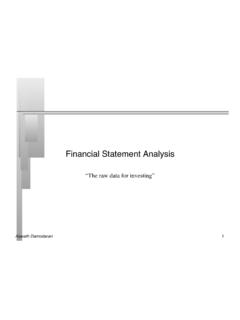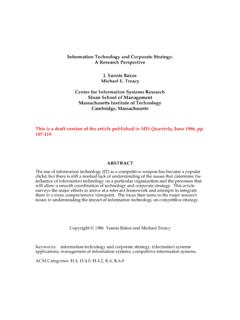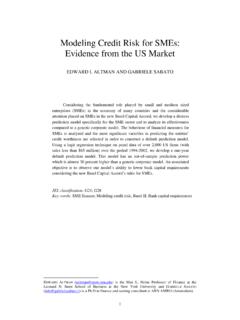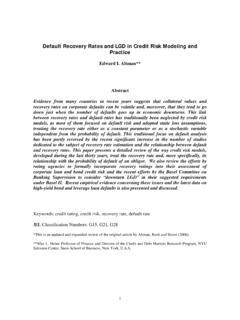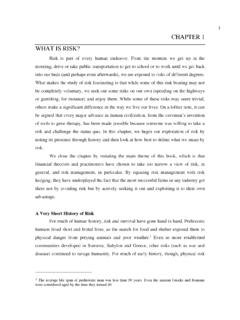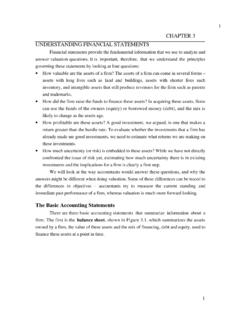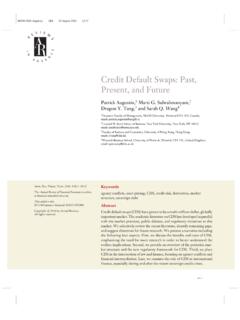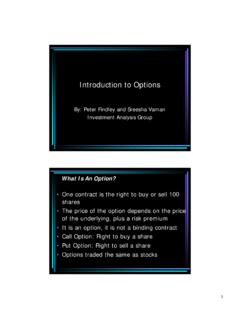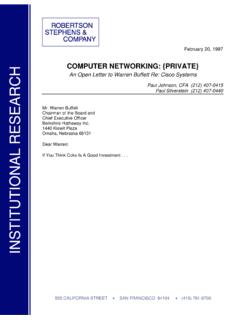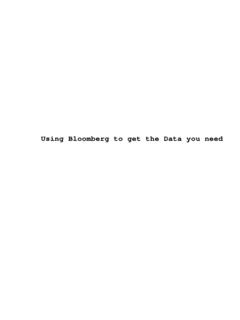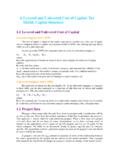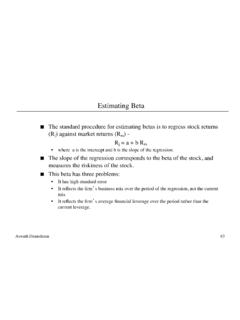Transcription of PRIVATE COMPANY VALUATION
1 PRIVATE COMPANY VALUATIONA swath DamodaranAswath Damodaran124125 Process of Valuing PRIVATE Companies The process of valuing PRIVATE companies is not different from the process of valuing public companies. You estimate cash flows, attach a discount rate based upon the riskiness of the cash flows and compute a present value. As with public companies, you can either value The entire business, by discounting cash flows to the firm at the cost of capital . The equity in the business, by discounting cashflows to equity at the cost of equity. When valuing PRIVATE companies, you face two standard problems: There is not market value for either debt or equity The financial statements for PRIVATE firms are likely to go back fewer years, have less detail and have more holes in Damodaran1251261. No Market Value? Market values as inputs: Since neither the debt nor equity of a PRIVATE business is traded, any inputs that require them cannot be ratios for going from unlevered to levered betas and for computing cost of prices to compute the value of options and warrants granted to employees.
2 Market value as output: When valuing publicly traded firms, the market value operates as a measure of reasonableness. In PRIVATE COMPANY VALUATION , the value stands alone. Market price based risk measures, such as beta and bond ratings, will not be available for PRIVATE businesses. Aswath Damodaran1261272. Cash Flow Estimation Issues Shorter history: PRIVATE firms often have been around for much shorter time periods than most publicly traded firms. There is therefore less historical information available on them. Different Accounting Standards: The accounting statements for PRIVATE firms are often based upon different accounting standards than public firms, which operate under much tighter constraints on what to report and when to report. Intermingling of personal and business expenses: In the case of PRIVATE firms, some personal expenses may be reported as business expenses.
3 Separating Salaries from Dividends : It is difficult to tell where salaries end and dividends begin in a PRIVATE firm, since they both end up with the Damodaran127128 PRIVATE COMPANY VALUATION : Motive matters You can value a PRIVATE COMPANY for Show valuationsnCuriosity: How much is my business really worth?nLegal purposes: Estate tax and divorce court Transaction valuationsnSale or prospective sale to another individual or PRIVATE entity. nSale of one partner s interest to anothernSale to a publicly traded firm As prelude to setting the offering price in an initial public offering You can value a division or divisions of a publicly traded firm As prelude to a spin off For sale to another entity To do a sum-of-the -parts VALUATION to determine whether a firm will be worth more broken up or if it is being efficiently Damodaran128129 PRIVATE COMPANY valuations: Four broad scenarios PRIVATE to PRIVATE transactions: You can value a PRIVATE business for sale by one individual to another.
4 PRIVATE to public transactions: You can value a PRIVATE firm for sale to a publicly traded firm. PRIVATE to IPO: You can value a PRIVATE firm for an initial public offering. PRIVATE to VC to Public: You can value a PRIVATE firm that is expected to raise venture capital along the way on its path to going Damodaran129130I. PRIVATE to PRIVATE transaction In PRIVATE to PRIVATE transactions, a PRIVATE business is sold by one individual to another. There are three key issues that we need to confront in such transactions: Neither the buyer nor the seller is diversified. Consequently, risk and return models that focus on just the risk that cannot be diversified away will seriously under estimate the discount rates. The investment is illiquid. Consequently, the buyer of the business will have to factor in an illiquidity discount to estimate the value of the business.
5 Key person value: There may be a significant personal component to the value. In other words, the revenues and operating profit of the business reflect not just the potential of the business but the presence of the current Damodaran130131An example: Valuing a restaurant Assume that you have been asked to value a upscale French restaurant for sale by the owner (who also happens to be the chef). Both the restaurant and the chef are well regarded, and business has been good for the last 3 years. The potential buyer is a former investment banker, who tired of the rat race, has decide to cash out all of his savings and use the entire amount to invest in the restaurant. You have access to the financial statements for the last 3 years for the restaurant. In the most recent year, the restaurant reported $ million in revenues and $ 400,000 in pre -tax operating profit.
6 While the firm has no conventional debt outstanding, it has a lease commitment of $120,000 each year for the next 12 Damodaran131132 Past income years ago2 years agoLast yearRevenues$800$1,100$1,200 Operating at full capacity- Operating lease expense$120$120$120(12 years left on the lease)- Wages$180$200$200(Owner/chef does not draw salary)- Material$200$275$300(25% of revenues)- Other operating expenses$120$165$180(15% of revenues)Operating income$180$340$400- Ta xe s$72$136$160(40% tax rate)Net Income$108$204$240 All numbers are in thousandsAswath Damodaran132133 Step 1: Estimating discount rates Conventional risk and return models in finance are built on the presumption that the marginal investors in the COMPANY are diversified and that they therefore care only about the risk that cannot be diversified.
7 That risk is measured with a beta or betas, usually estimated by looking at past prices or returns. In this VALUATION , both assumptions are likely to be violated: As a PRIVATE business, this restaurant has no market prices or returns to use in estimation. The buyer is not diversified. In fact, he will have his entire wealth tied up in the restaurant after the purchase. Aswath Damodaran133134No market price, no Use bottom-up betas to get the unlevered beta The average unlevered beta across 75 publicly traded restaurants in the US is A caveat: Most of the publicly traded restaurants on this list are fast-food chains (McDonald s, Burger King) or mass restaurants (Applebee s, ) There is an argument to be made that the beta for an upscale restaurant is more likely to be reflect high-end specialty retailers than it is restaurants.
8 The unlevered beta for 45 high-end retailers is Aswath Damodaran13480 unitsof firm specificrisk20 units of market riskPrivate owner of businesswith 100% of your weatlthinvested in the businessPublicly traded companywith investors who are diversifiedIs exposedto all the riskin the firmDemands acost of equitythat reflects thisriskEliminates firm-specific risk in portfolioDemands acost of equitythat reflects only market riskMarket Beta measures justmarket riskTotal Beta measures all risk= Market Beta/ (Portion of the total risk that is market risk) PRIVATE Owner versus Publicly Traded COMPANY Perceptions of Risk in an InvestmentAswath Damodaran135136 Estimating a total beta To get from the market beta to the total beta, we need a measure of how much of the risk in the firm comes from the market and how much is firm-specific.
9 Looking at the regressions of publicly traded firms that yield the bottom-up beta should provide an answer. The average R-squared across the high-end retailer regressions is 25%. Since betas are based on standard deviations (rather than variances), we will take the correlation coefficient (the square root of the R-squared) as our measure of the proportion of the risk that is market risk. Total unlevered Beta= Market Beta/ Correlation with the market= / = Damodaran136137 The final step in the beta computation: Estimate a Debt to equity ratio and cost of equity With publicly traded firms, we re-lever the beta using the market D/E ratio for the firm. With PRIVATE firms, this option is not feasible. We have two alternatives: Assume that the debt to equity ratio for the firm is similar to the average market debt to equity ratio for publicly traded firms in the sector.
10 Use your estimates of the value of debt and equity as the weights in the computation. (There will be a circular reasoning problem: you need the cost of capital to get the values and the values to get the cost of capital .) We will assume that this privately owned restaurant will have a debt to equity ratio ( ) similar to the average publicly traded restaurant (even though we used retailers to the unlevered beta). levered beta = (1 + ( ) (.1433)) = cost of equity = + (4%) = (T Bond rate was at the time; 4% is the equity risk premium) Aswath Damodaran137138 Estimating a cost of debt and capital While the firm does not have a rating or any recent bank loans to use as reference, it does have a reported operating income and lease expenses (treated as interest expenses)Coverage Ratio = Operating Income/ Interest (Lease) Expense= 400,000/ 120,000 = based on coverage ratio = BB+Default spread = -tax cost of debt = (Riskfreerate + Default spread) (1 tax rate) = ( + ) (1.)
